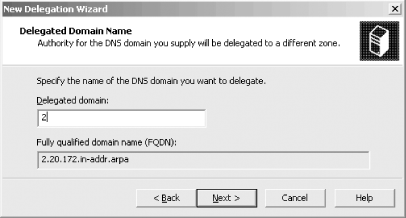Subnetting on an Octet Boundary
Since Movie U. has just three /24 (Class C-sized) networks, one per segment, there’s no particular need to subnet those networks. However, our sister university, Altered State, has a Class B-sized network, 172.20/16. Their network is subnetted between the third and fourth octet of the IP address; that is, their subnet mask is 255.255.255.0. They’ve already created a number of subdomains of their domain: altered.edu, including fx.altered.edu (okay, we copied them); makeup.altered.edu; and foley.altered.edu. Since each of these departments also runs its own subnet (their Special Effects department runs subnet 172.20.2/24, Makeup runs 172.20.15/24, and Foley runs 172.20.25/24), they’d like to divvy up their in-addr.arpa namespace appropriately, too.
Delegating in-addr.arpa subdomains is no different from delegating subdomains of forward-mapping domains. First, they or their departments create three new zones, 2.20.172.in-addr.arpa, 15.20.172.in-addr.arpa, and 25.20.172.in-addr.arpa. The 20.172.in-addr.arpa administrators also need to add the NS records with the New Delegation Wizard, as we described in the fx.movie.edu example earlier in this chapter. Figure 10-7 shows how the second screen of the New Delegation Wizard would look when adding delegation to the 2.20.172.in-addr.arpa zone:
 |
Get DNS on Windows Server 2003, 3rd Edition now with the O’Reilly learning platform.
O’Reilly members experience books, live events, courses curated by job role, and more from O’Reilly and nearly 200 top publishers.

